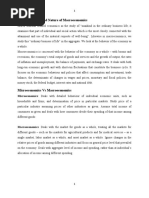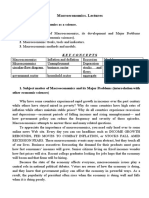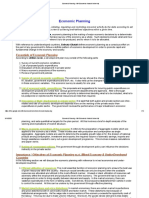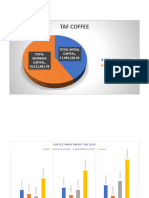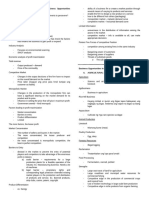0 ratings0% found this document useful (0 votes)
10 viewsMacro 01
Macro 01
Uploaded by
Malcolm HolmesThis document provides an introduction to macroeconomics. It discusses that macroeconomics focuses on analyzing whole economies and addressing questions like what causes recessions and unemployment. It examines macroeconomics from three perspectives: macroeconomic goals of growth, low unemployment, and low inflation; frameworks like aggregate demand and supply; and policy tools of monetary and fiscal policy. National governments use monetary policy involving interest rates and money supply and fiscal policy involving taxes and spending to influence the macroeconomy.
Copyright:
© All Rights Reserved
Available Formats
Download as PDF, TXT or read online from Scribd
Macro 01
Macro 01
Uploaded by
Malcolm Holmes0 ratings0% found this document useful (0 votes)
10 views14 pagesThis document provides an introduction to macroeconomics. It discusses that macroeconomics focuses on analyzing whole economies and addressing questions like what causes recessions and unemployment. It examines macroeconomics from three perspectives: macroeconomic goals of growth, low unemployment, and low inflation; frameworks like aggregate demand and supply; and policy tools of monetary and fiscal policy. National governments use monetary policy involving interest rates and money supply and fiscal policy involving taxes and spending to influence the macroeconomy.
Copyright
© © All Rights Reserved
Available Formats
PDF, TXT or read online from Scribd
Share this document
Did you find this document useful?
Is this content inappropriate?
This document provides an introduction to macroeconomics. It discusses that macroeconomics focuses on analyzing whole economies and addressing questions like what causes recessions and unemployment. It examines macroeconomics from three perspectives: macroeconomic goals of growth, low unemployment, and low inflation; frameworks like aggregate demand and supply; and policy tools of monetary and fiscal policy. National governments use monetary policy involving interest rates and money supply and fiscal policy involving taxes and spending to influence the macroeconomy.
Copyright:
© All Rights Reserved
Available Formats
Download as PDF, TXT or read online from Scribd
Download as pdf or txt
0 ratings0% found this document useful (0 votes)
10 views14 pagesMacro 01
Macro 01
Uploaded by
Malcolm HolmesThis document provides an introduction to macroeconomics. It discusses that macroeconomics focuses on analyzing whole economies and addressing questions like what causes recessions and unemployment. It examines macroeconomics from three perspectives: macroeconomic goals of growth, low unemployment, and low inflation; frameworks like aggregate demand and supply; and policy tools of monetary and fiscal policy. National governments use monetary policy involving interest rates and money supply and fiscal policy involving taxes and spending to influence the macroeconomy.
Copyright:
© All Rights Reserved
Available Formats
Download as PDF, TXT or read online from Scribd
Download as pdf or txt
You are on page 1of 14
MODULE 01
Introduction to the Macroeconomic
Perspective
Macroeconomics focuses on the
economy as a whole (or on whole
economies as they interact).
What causes recessions?
What makes unemployment stay high
when recessions are supposed to be
over? Why do some countries grow
faster than others?
Why do some countries have higher
standards of living than others? These
are all questions that
macroeconomics addresses.
Macroeconomics involves adding up
the economic activity of all
households and all businesses in all
markets to get the overall demand
and supply in the economy.
We will study macroeconomics from
three different perspectives:
1.What are the macroeconomic goals?
2.What are the frameworks economists
can use to analyze the macroeconomy?
3.Finally, what are the policy tools
governments can use to manage the
macroeconomy?
Macroeconomic Goals, Framework,
and Policies. This chart shows what
macroeconomics is about.
The box on the left indicates a
consensus of what are the most
important goals for the macro
economy, the middle box lists the
frameworks economists use to analyze
macroeconomic changes (such as
inflation or recession), and the box on
the right indicates the two tools the
federal government uses to influence
the macro economy.
Goals
In thinking about the overall health of
the macroeconomy, it is useful to
consider three primary goals:
economic growth, low
unemployment, and low inflation.
Economic growth ultimately
determines the prevailing standard of
living in a country.
Economic growth is measured by the
percentage change in real (inflation-
adjusted) gross domestic product. A
growth rate of more than 3% is
considered good.
Unemployment, as measured by the
unemployment rate, is the percentage
of people in the labor force who do
not have a job. When people lack jobs,
the economy is wasting a precious
resource-labor, and the result is lower
goods and services produced.
Unemployment, however, is more
than a statistic—it represents people’s
livelihoods. While measured
unemployment is unlikely to ever be
zero, a measured unemployment rate
of 5% or less is considered low
(good).
Inflation is a sustained increase in the
overall level of prices, and is measured
by the consumer price index. If many
people face a situation where the
prices that they pay for food, shelter,
and healthcare are rising much faster
than the wages they receive for their
labor, there will be widespread
unhappiness as their standard of
living declines.
Frameworks
In microeconomics, we used the
theories of supply and demand; in
macroeconomics, we use the theories
of aggregate demand (AD) and
aggregate supply (AS).
Policy Tools
National governments have two tools
for influencing the macroeconomy.
The first is monetary policy, which
involves managing the money supply
and interest rates. The second is fiscal
policy, which involves changes in
government spending/purchases and
taxes.
THANK YOU.
• References:
• https://opentextbc.ca/principlesofeconomics/chapter/introdu
ction-to-the-macroeconomic-perspective/
• For Classroom discussion use only
You might also like
- ECON 101 Course SyllabusDocument3 pagesECON 101 Course SyllabusDGDelfin100% (1)
- Intro MacroDocument27 pagesIntro Macroanon_582786458No ratings yet
- Intro MacroDocument23 pagesIntro MacroJigar ShahNo ratings yet
- Ow Is The Economy Doing? How Does One Tell?: Introduction To The Macroeconomic PerspectiveDocument106 pagesOw Is The Economy Doing? How Does One Tell?: Introduction To The Macroeconomic Perspectivewilliam olandoNo ratings yet
- Basics of MacroeocnomcisDocument19 pagesBasics of MacroeocnomcisNo MoreNo ratings yet
- Macro EconomicDocument48 pagesMacro EconomicMohammed AdemNo ratings yet
- Macro AauDocument49 pagesMacro AauMohammed AdemNo ratings yet
- Bbek4203-Principles of MacroeconomicsDocument13 pagesBbek4203-Principles of Macroeconomicsmunib zakaria100% (1)
- MacroeconomicDocument28 pagesMacroeconomicNeelam FartyalNo ratings yet
- Macro EconomicsDocument5 pagesMacro Economicsshahshahsb698No ratings yet
- CH 2 Basic Economic QuestionsDocument20 pagesCH 2 Basic Economic QuestionsRiemann SolivenNo ratings yet
- Macro-Economics of Financial Markets BFM Black BookDocument74 pagesMacro-Economics of Financial Markets BFM Black BookJameson KurianNo ratings yet
- 2 AE12 Introduction To MacroeconomicsDocument21 pages2 AE12 Introduction To MacroeconomicsJACQUELYN PABLITONo ratings yet
- ASSIGNMENTDocument24 pagesASSIGNMENTKalpana BisenNo ratings yet
- ECN 221 Notes, 2015Document49 pagesECN 221 Notes, 2015iqmobiletutorNo ratings yet
- MacroeconomicsDocument1 pageMacroeconomicsngp46m8gr5No ratings yet
- 1. Key concepts of MacroeconomicsDocument5 pages1. Key concepts of MacroeconomicsShahparan IslamNo ratings yet
- Micro and Macro EconomicsDocument6 pagesMicro and Macro EconomicsSiva KumarNo ratings yet
- Chapter 1 IntroDocument14 pagesChapter 1 IntroliyayudiNo ratings yet
- Introduction To Macroeconomics PDFDocument16 pagesIntroduction To Macroeconomics PDFJessyca Asih Putri GultomNo ratings yet
- CHAPTER ONE: Introduction To Macroeconomics What Macroeconomics Is AboutDocument7 pagesCHAPTER ONE: Introduction To Macroeconomics What Macroeconomics Is AboutAyazNadeemNo ratings yet
- Handout - 3Document5 pagesHandout - 3Jarin TasnimNo ratings yet
- Eco 202 NotesDocument14 pagesEco 202 NotesTerpase NomorNo ratings yet
- W1L1 TranscriptDocument7 pagesW1L1 Transcriptsumitdwivedi0808No ratings yet
- IGCSE Economics Chapter 30 Key Concept - Macroeconomic ObjectivesDocument2 pagesIGCSE Economics Chapter 30 Key Concept - Macroeconomic ObjectivesemilyNo ratings yet
- PMG Sem-2 Macro-1 2 PDFDocument206 pagesPMG Sem-2 Macro-1 2 PDFanushkaNo ratings yet
- BE Unit III IVDocument38 pagesBE Unit III IVdaskhushi8851No ratings yet
- Chapter 1Document14 pagesChapter 1HayamnotNo ratings yet
- Macroeco 1Document5 pagesMacroeco 1sajal_stha205_954707No ratings yet
- Micro EconomicsDocument128 pagesMicro EconomicsfeisalNo ratings yet
- Health EconomicsDocument27 pagesHealth EconomicsUsman Ahmad TijjaniNo ratings yet
- Bcom 206Document45 pagesBcom 206ksucheta013No ratings yet
- ECO 202 Lecture NotesDocument64 pagesECO 202 Lecture NotesRealhabeeebNo ratings yet
- Macroeconomics Reviewer PDFDocument9 pagesMacroeconomics Reviewer PDFMicah UbaldoNo ratings yet
- Macro Chapter 1&2Document21 pagesMacro Chapter 1&2tekalignNo ratings yet
- Week 2 Economics As Applied ScienceDocument5 pagesWeek 2 Economics As Applied ScienceJasmin EspeletaNo ratings yet
- Introduction To MacroDocument12 pagesIntroduction To MacroSophiya PrabinNo ratings yet
- Malaysia 2005 2010 Macroeconomic IssuesDocument22 pagesMalaysia 2005 2010 Macroeconomic IssuesTim Fipps100% (2)
- Macroeconomics Topic 1 LectureDocument11 pagesMacroeconomics Topic 1 LectureКатеринаNo ratings yet
- Theories of EconomicsDocument37 pagesTheories of EconomicsKartik SharmaNo ratings yet
- Unit I MacroeconomicsDocument26 pagesUnit I Macroeconomicsyashanand235No ratings yet
- MacroEconomics ProjectDocument3 pagesMacroEconomics ProjectTrangNo ratings yet
- Unit 1 (Introduction To Macro Eco.)Document16 pagesUnit 1 (Introduction To Macro Eco.)AmritNo ratings yet
- Chapter 1 MacroDocument19 pagesChapter 1 Macroabyu adaneNo ratings yet
- Introduction To Macroeconomics: Notes and Summary of ReadingsDocument27 pagesIntroduction To Macroeconomics: Notes and Summary of ReadingsSumon AkhtarNo ratings yet
- B.E - II Notes (Bba 4205)Document45 pagesB.E - II Notes (Bba 4205)AQUA RAZE YTNo ratings yet
- SHS Applied Eco Module - 19 and 20Document10 pagesSHS Applied Eco Module - 19 and 20Ronald AlmagroNo ratings yet
- Module 6 & 7Document10 pagesModule 6 & 7Chin Keanna BuizonNo ratings yet
- Output and IncomeDocument3 pagesOutput and IncomeAnonymous JOOQkGbwoRNo ratings yet
- EHT 305Document16 pagesEHT 305SANI MUHAMMADNo ratings yet
- Notes MEDocument37 pagesNotes MEtanakamuzira20No ratings yet
- Unit 1 Study MaterialDocument25 pagesUnit 1 Study MaterialKhushi ShahNo ratings yet
- MACRODocument2 pagesMACROjandhansamriddhisocietyNo ratings yet
- Macroeconomics_Document4 pagesMacroeconomics_Sherif MohamedNo ratings yet
- Session 1 Introduction To MacroeconomicsDocument7 pagesSession 1 Introduction To MacroeconomicsdboterNo ratings yet
- Nature and Scope of Macro-Economics: TH THDocument15 pagesNature and Scope of Macro-Economics: TH THParth SharmaNo ratings yet
- Hitesh Tandon Bitm Macroeconomics NotesDocument15 pagesHitesh Tandon Bitm Macroeconomics Notesshubham chatterjeeNo ratings yet
- Gale Researcher Guide for: Policy Responses to the Business CycleFrom EverandGale Researcher Guide for: Policy Responses to the Business CycleNo ratings yet
- Living in The It Era - Reviewer 2Document14 pagesLiving in The It Era - Reviewer 2Malcolm HolmesNo ratings yet
- Macro 03Document14 pagesMacro 03Malcolm HolmesNo ratings yet
- Macro 02Document14 pagesMacro 02Malcolm HolmesNo ratings yet
- Religious Education For College - Augustinian ValuesDocument4 pagesReligious Education For College - Augustinian ValuesMalcolm HolmesNo ratings yet
- REV Midterms MacroDocument5 pagesREV Midterms MacroMalcolm HolmesNo ratings yet
- Financial Accounting and Reporting (FAR) - Part 1Document6 pagesFinancial Accounting and Reporting (FAR) - Part 1Malcolm HolmesNo ratings yet
- Financial Accounting and Reporting (FAR) - Part 5Document3 pagesFinancial Accounting and Reporting (FAR) - Part 5Malcolm HolmesNo ratings yet
- Financial Accounting and Reporting (FAR) - Part 3Document4 pagesFinancial Accounting and Reporting (FAR) - Part 3Malcolm HolmesNo ratings yet
- Financial Accounting and Reporting (FAR) - Part 2Document5 pagesFinancial Accounting and Reporting (FAR) - Part 2Malcolm HolmesNo ratings yet
- Economic Planning - MA Economics Karachi UniversityDocument12 pagesEconomic Planning - MA Economics Karachi UniversitySharina ObogNo ratings yet
- UnemploymentDocument11 pagesUnemploymentVinay Kumar KumarNo ratings yet
- Virtual Instruction Lesson - 5.6 - Economic GrowthDocument32 pagesVirtual Instruction Lesson - 5.6 - Economic GrowthparminderpcsNo ratings yet
- Tax Policy Center Briefing Book - 2018.1Document561 pagesTax Policy Center Briefing Book - 2018.1lucasrsv1No ratings yet
- แนวข้อสอบภาษาอังกฤษ ชุดที่ 2Document6 pagesแนวข้อสอบภาษาอังกฤษ ชุดที่ 2Sukrit JaideeNo ratings yet
- Bt11703 Course Outline 2015Document4 pagesBt11703 Course Outline 2015Jasz Azliey AzzamNo ratings yet
- India's Current Employment ScenarioDocument8 pagesIndia's Current Employment ScenarioDipanshu DipanshuNo ratings yet
- Macro Essential QuestionsDocument3 pagesMacro Essential QuestionsChinmay PanhaleNo ratings yet
- Activity 1 - Economic DevelopmentDocument2 pagesActivity 1 - Economic Developmentkhristian corderoNo ratings yet
- C3 - Accounting For InventoriesDocument95 pagesC3 - Accounting For InventoriesHồ ThảoNo ratings yet
- Econ CommentaryDocument3 pagesEcon Commentarytrayi reddyNo ratings yet
- Difference Between Absolute and Relative Poverty (With Table)Document7 pagesDifference Between Absolute and Relative Poverty (With Table)Arundhuti Roy50% (2)
- Financial Plan For Coffee ShopDocument30 pagesFinancial Plan For Coffee ShopWondwossen TegegnNo ratings yet
- Solution: Macroeconomics: The Big PictureDocument6 pagesSolution: Macroeconomics: The Big PictureStefan Neagoe100% (2)
- Eco Mock Test 02 SPCCDocument3 pagesEco Mock Test 02 SPCCsattwikd77No ratings yet
- Y9 Econs Sem 2 Exam AnswersDocument5 pagesY9 Econs Sem 2 Exam AnswersJIE MIN CHANNo ratings yet
- Cambridge IGCSE: ECONOMICS 0455/23Document8 pagesCambridge IGCSE: ECONOMICS 0455/23Rima MalkiNo ratings yet
- Cause and Effect of Unemployment in Addis Ababa: The Case Study Gulele SubcityDocument39 pagesCause and Effect of Unemployment in Addis Ababa: The Case Study Gulele SubcitysteveiamidNo ratings yet
- Economy KeyDocument12 pagesEconomy KeyCristiSantínNo ratings yet
- POVERTY PPT 14Document76 pagesPOVERTY PPT 14Shubhankar ThakurNo ratings yet
- Basic MacroeconomicsDocument151 pagesBasic Macroeconomicsworkiemelkamu400No ratings yet
- Chapter 2 PowerPointDocument19 pagesChapter 2 PowerPoints1857591No ratings yet
- CH 02 Sec 02Document14 pagesCH 02 Sec 02datdude1415No ratings yet
- World Report On Child LabourDocument19 pagesWorld Report On Child LabourShanzeh MalikNo ratings yet
- Econ ReviewerDocument4 pagesEcon ReviewerLiana MarielleNo ratings yet
- Umemployment in IndiaDocument14 pagesUmemployment in IndiaHeena ShaikhNo ratings yet
- Bring Back Lost Lovers +27717523226 in Johannesburg Cape Town USA Kimberly Zimbabwe USA East LondonDocument2 pagesBring Back Lost Lovers +27717523226 in Johannesburg Cape Town USA Kimberly Zimbabwe USA East Londonlimbagwe23No ratings yet
- June 2018 Question Paper 21Document8 pagesJune 2018 Question Paper 21Walter ShonisaniNo ratings yet
- Poverty & Inequality (Uruguay)Document17 pagesPoverty & Inequality (Uruguay)Stephanie CliffNo ratings yet





